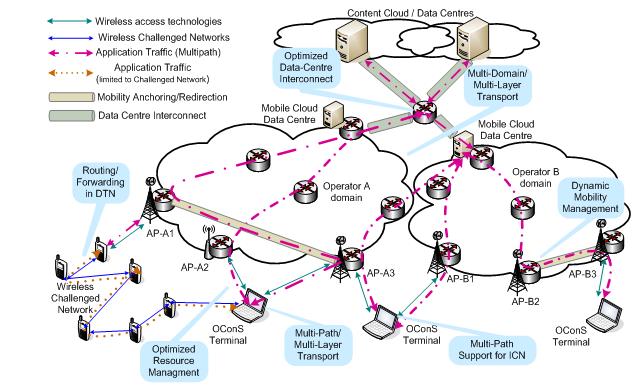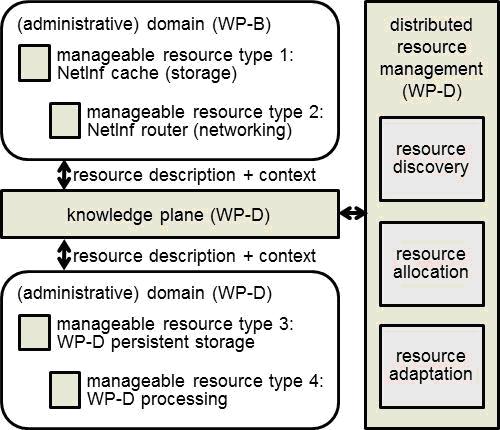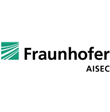Below is the 4th quarterly newsletter from the SAIL project. A printable, PDF, version of the SAIL newsletter #4 can be downloaded here.
You may subscribe to the quarterly newsletters from SAIL by entering your email address in the form below.
1. Editorial
For most people, summer means vacation, but this summer in SAIL, we did more than enjoying the sun and the beach. Five important documents have been delivered to the EU commission, and it is now your turn to enjoy the harvest as we made those documents available on our web site.
During the project’s first phase, we put a large effort on defining the architecture to support the concepts that we introduced in the use cases and scenario Deliverable (D.A.1) earlier this year.
The “Draft Architecture Guidelines and Principles” (D.A.2) Deliverable presents, as its name says it, principles and guidelines applicable to the architecture work being done in SAIL. This includes contributions from the Themes defining objectives, frameworks, and early results. The document also includes a simplified view of SAIL’s overall architecture, identifying the main interfaces between WPs.
The architecture for the Information Centric Networking (ICN) approach has been described in “The Network of Information: Architecture and Applications” (D.B.1). The document presents different design options for the core building blocks of an ICN: naming, name resolution, forwarding and routing, and mobility and security. The document studies how the architecture applies to the selected applications and use cases, and also describes recent work in NetInf migration and standardisation.
In “Architectural Concepts of Connectivity Services” (D.C.1), OConS proposes a new set of networking architecture principles. It describes the functional entities and interfaces of the architectural framework that suits these new requirements. It then describes the proposed connectivity services and their management mechanisms. Finally, these elements are mapped to the connectivity use cases and scenarios.
CloNe integrates networks and data centres, considers the networking resources into the existing data centre infrastructure, and allows the application to use computing and storage resource distributed in the network for a better end-user experience, and all this in multi-administrative domain scenarios. “Cloud Network Architecture Description” (D.D.1) describes the architecture to support these features from intra- and inter-domain perspectives.
When introducing new technologies as we do in SAIL, it is not enough to identify the technical issues, but we also need to evaluate the impacts on the business and the society. ”New Business Models and Business Dynamics of the Future Networks” (D.A.7) studies the intangible, business and regulatory aspects of selected use cases.
As the project now will shift focus towards prototyping of the concepts outlined in these documents, we conclude our in-depth tutorials of our WPs by putting extra spotlight focus on the Open Connectivity Services work!
Enjoy the reading.
Thomas Edwall (Project Manager)
Benoit Tremblay (Technical Manager)
2. Under the Spotlight:
Focus on WP-C – Open Connectivity Services
During the last months, the focus in OConS was put on our first deliverable, “Architectural Concepts of Connectivity Services“. We have started thus with a comprehensive analysis, which discusses and challenges the current networking guidelines and principles, and, whenever necessary, we have proposed changes and adaptations. Knowing that current networking abstractions are not appropriate to deal with the increasingly complex landscape, we have clearly identified and proposed the following abstractions and functional entities common to all mechanisms: IE – Information management (e.g., networking context/view), DE – Decision (e.g., path computation), EE – Execution (e.g. forwarding), Orchestration (i.e., toolbox and blueprint to deal with a given service request), and Path/Connection-emulation (e.g., similar to bearers in 3GPP, VLAN/tags in PBB-TE, or paths/labels in MPLS/LDP/RSVP-TE).
We reckon that our approach enables a smooth possible grouping (i.e., layering) of these abstractions/entities into major communication functions, and, moreover, we facilitate the support of several instantiation models (e.g., centralised path computation, several degree of hierarchysation for resource management, fully decentralised forwarding and mobility execution). Likewise, we will define, and intend to standardise, open/extensible interfaces to operate on these abstractions/entities, e.g., on DE-EE we can use an OpenFlow-like enriched with OConS services and policies, on IE-DE we can use appropriate triggers depending on a given connectivity service sought, on DE-DE we need inter-domain exchanges, and through the external API we manipulate the connectivity path through the Orchestration toolbox.
In D.C.1, we have also detailed several advanced connectivity services, such as: Multi-Path mechanisms that allow the same flow to use multiple simultaneous paths in a fair and efficient way, mechanisms to support Multi-homed nodes for effective handover and for delivering a given flow to multiple points, Multi-Protocol mechanisms for dynamically selecting different transport protocols and configuring the parameters for a given flow, mechanisms that assist ICN to benefit from the established multiple paths at the transport and network layers, integration of network-coding and cross-layer techniques to improve the performance of Multi-P* mechanisms, and end-to-end network control for supporting the WAN interconnectivity. Likewise, D.C.1 specifies a set of mechanisms to manage and control these connectivity services in an efficient and scalable way, thus, it specifically tackles: dynamic and distributed mobility management, security aspects in relation with mobility, and resource management mechanisms (e.g., cognitive radio through spectrum sensing, radio resource allocation, wireless mesh and DTN management, policy routing, and overlaying for data-centre interconnection).
By providing a set of abstractions and interfaces that can be grouped into networking functions and services in a flexible and adaptable way, we can definitely say that the OConS framework decreases the networking landscape complexity, allowing for easier evolutions; accordingly, the functions can be reused at several layers, instantiated on various models, being orchestrated on-demand through open APIs. Finally, we aim at a recursive/reflexive use of a given OConS mechanism (where it can call itself with the same or with a different input/policy), so instead of throwing-in more protocols and mechanisms, we can reuse and instantiate the existing ones within appropriate “networking-processing” nodes or slices (in CloNe vocabulary).
3. Inside SAIL:
News from WPs and Themes
WP-A
Impact and Collaboration Enabling (ICE)
Since the last newsletter, Deliverable D.A.7 “New Business Models and Business Dynamics of the Future Networks” has been finalised and made public. The document explores the business and socio-economics aspects that influence the SAIL architecture. In order for the results and output from SAIL to be relevant in the existing and future business environment, it is important to actively research these aspects, and to incorporate the findings in the technical work. All the technical WPs have been involved in the work, to provide input and insight and also to ensure a direct incorporation during the way forward. The deliverable is also relevant outside the scope of SAIL, and should be an interesting reading for you all.
Regulatory and legal aspects of the SAIL concept are another critical success factor for SAIL. In the last few months, SAIL has hosted workshops in Finland and Sweden around these questions. The workshops had participants from a variety of relevant stakeholders, ranging from content providers and operators, to regulatory authorities and others. Also, the participants were a mix of both technical as well as legal experts.
WP-B
Network of Information (NetInf)
WP-B is developing an ICN architecture with a focus on support for heterogeneous technological and administrative domains, which is described in more detail in D.B.1 “The Network of Information: Architecture and applications” (http://www.sail-project.eu/deliverables).
This document presents the NetInf design that is centred around a well-defined set of architecture invariants (such as unique naming, location-independence and a strict information-centric service model), putting a particular emphasis on supporting multi-technology/multi-domain interoperability. These invariants provide the necessary orientation for the more detailed architecture elements, such as naming, transport, caching, etc. Based on these invariants, an overview of a complete NetInf system that illustrates the relation of the architecture elements in a big picture is presented. The presented architecture building blocks can be used to construct full or parts of the NetInf architecture, such as name resolution, forwarding and routing, mobility and security for different use cases, and migration paths.
Different prototypes are built based on this set of architecture elements, and SAIL has recently released a new version of the OpenNetInf software distribution (http://www.netinf.org).
We continue working together with the general ICN research community, and SAIL members have been co-organising the highly successful ICN workshop at this year’s ACM SIGCOMM (http://www.neclab.eu/icn-2011). The workshop received 41 submissions from Asia, Europe, and North America (China, Finland, France, Germany, Greece, Ireland, Israel, Italy, Netherlands, Norway, Sweden, South-Korea, Switzerland, UK, USA), out of which 12 papers have been accepted for the final program — the acceptance rate was 29%.
WP-C
Open Connectivity Service (OConS)
Under the spotlight in this issue.
WP-D
Cloud Networking (CloNe)
The objective of WP-D is to create an architecture for cloud networking and flash network slice over multiple, typically heterogeneous, multi-administrative domains. To explore this architecture in more details, control functions and protocols, management and security aspects are addressed. To evaluate all solution in a large scale prototype, a testbed hosted by three different partners is set up. This prototype will proof feasibility of the solutions and a migration approach.
The architectural solution, including security and management framework, was documented and delivered. Some of the contributions in this architecture are the concept of Flash Network Slices (FNS) as a space of interconnected end-points with specific QoS guarantees and dynamic reconfiguration properties. The FNS is mapped to three different platforms namely, flow based networks (e.g., OpenFlow), fully virtualised networks (e.g., 4WARD VNet) and virtual private networks (VPNs).
The interfaces between the different parts of the cloud networking eco-system have been identified and their nature specified. Two different control protocols have been defined, enabling the CloNe vision. The first one is a RESTful Infrastructure Service Interface, based on an extension of the existing OCCI standard, thus, being migration friendly. In the second one, the distributed control plane will be used to enable cross domain interaction and signalling.
Prototyping and Experimentation Theme
As a contribution to D.A.2, the theme provided principles for a prototyping, experimentation and demonstration framework architecture, giving some guidelines how to design, manage and conduct experiments for test and validation.
Moreover, in the context of prototyping, the contribution also discusses the risks from using Free and Open Source Software (FOSS) and gives principles and guidelines how to deal with this issue in the project. The use and/or distribution of FOSS has numerous advantages to the project partners, however, there are also disadvantages, including the complexity of FOSS licensing (e.g., when a FOSS distribution has multiple “dependencies”, each subject to different license terms, and potential issues associated with ownership of intellectual property originating from unknown and questionable sources, etc.). The purpose of the FOSS guidelines given in D.A.2 is to maximise the benefits of FOSS to the SAIL project while mitigating the associated risks.
The face-to-face Theme Prototyping meeting during the 3rd SAIL Plenary Meeting in Paderborn showed a broad interest in this theme activity, as it is now approaching one of the highlights of the project: the first project-internal prototyping, demonstration and experimentation workshop to show, discuss and align the practical project achievements across the SAIL work packages. This workshop is scheduled to be held in Jan. 2012 in conjunction with the 4th general project meeting hosted by IST/Lisbon, Portugal. The event is now being prepared as a forum for project-internal experience exchange and a basis for further project-wide integration towards the project end. To present a comprehensive and sound story for the public demonstration event at the project end (Dec. 2012), people eagerly started to discuss a common storyboard around the scenario and use cases of a realistic “flash crowd event” (e.g., the Royal wedding) as presented at the past FIA meeting in Warsaw.
Security Theme
Despite the diversity of the security and privacy related research topics, which are addressed in the WP-B, WP-C and WP-D, the theme members identified common guidelines and methodology. Both, common ground and WP specific ambitions in protection goals, are documented and discussed in context, amongst other architectural aspects, in D.A.2 “Draft Architecture Guidelines and Principles“.
This first year result is now carried forward and the security theme prepares the strategy to validate that the implementation of security and privacy objectives is well-coordinated across WPs, i.e., this implementation avoids duplication of work and appears being consistent.
Network Management Theme
At the end of the fourth quarter, the network management theme has completed the first version of a project‑wide management architecture. The theme provides the following main contributions:
- Definition of a concise set of management guidelines: the network management theme has defined five fundamental guidelines according to which management functions shall be implemented in individual parts of SAIL’s overall architecture. Compliance with these guidelines assures that architectural elements (e.g., NetInf caches) are understood as manageable resources with known context (e.g., security constraints), which interoperate via defined management interfaces, and which adhere to the same data models that define the management data processed and exchanged by manageable resources.
- WP-specific application of management guidelines and concepts: based on the definition of the management guidelines, the network management theme has illustrated how to apply network management concepts uniformly to the individual WPs’ architectures. In doing so, the theme has applied a WP-D-centric view, in which WP-D’s key management concepts are applied in the context of other WPs consistent with the guidelines.
- Inter-WP application of management guidelines and concepts: the network management theme has further illustrated how guideline adherence facilitates and eases the creation of homogeneous and comprehensive network management architecture that spans all of the technical WPs (WP-B, WP-C, and WP-D). For example, it was shown how interfacing with a shared knowledge plane can benefit the various WPs in performing their management tasks, e.g., how WP-D is able to more flexibly create flash slices based on more extensive knowledge about storage resources.
In the second year, the network management theme will focus on refining the proposed architecture and address important open management questions, such as the investigation of the layering of the different work packages’ architectures with respect to one another, and how such layering impacts the overall management architecture.
4. Looking Outside:
Views on SAIL
Article in SvD
SAIL has once again got media coverage in Sweden. On May 30, Svenska Dagbladet (SvD), one of the major daily newspapers, had detailed article on SAIL as an example of new innovative initiatives for the third phase of the internet evolution “Internet sailing on the third wave of SAIL” (Google translated version).
IEEE article
During fall 2010, IEEE Communications Magazine issued a call for papers addressing “Future Internet Architectures: Design and Deployment Perspectives”, with a deadline on Dec. 2010. As this topic was right on the target for SAIL, a group of people in the project was set up to write the paper, and did manage to submit the paper in due time: “Content, Connectivity, and Cloud: Ingredients for the Network of the Future”, Bengt Ahlgren, Pedro A. Aranda, Prosper Chemouil, Luis M. Correia, Holger Karl, Sara Oueslati, Michael Söllner and Annikki Welin. The paper was accepted (from an acceptance ratio of 15%), and was published in the July issue of the journal. Recently, we became aware that this article was in the top ten of the most read in IEEE Communications Society, for that month.
FuNeMS Warsaw
The project actively participated at the ‘Future Networks & Mobile Summit‘ in Warsaw. A t FuNeMS, SAIL had a poster stand in the exhibition hall where the work of all WPs was presented. Two blog posts from FuNeMS were published on Sailors Inn:
- http://www.sail-project.eu/sailorsinn/2011/06/sail-funems-warzaw/
- http://www.sail-project.eu/sailorsinn/2011/06/grand-vision-european-network-research/
The following papers have been accepted or published:
- Mehani Olivier, Boreli Roksana, Maher Michael, Ernst Thierry, “User- and Application-Centric Multihomed Flow Management”, 36th IEEE Conference on Local Computer Networks, Bonn, Germany, 4-7 October, 2011.
- Lúcio Studer Ferreira, Luís M. Correia, “Radio Resource Management for Optimising Multi-Radio Wireless Mesh Networks Deployments”, WPMC 2011: 14th International Symposium on Wireless Personal and Mobile Communications, Brest, France, 3-7 Oct. 2011.
- B. Ahlgren, B. Ohlman, E. Axelsson, and L. Brown, “Subversion Over Open NetInf and CCNx”, WASA-NGI-IV, Bonn, Germany, 4 October 2011.
- Aidan Lynch, Stephen Farrell, Alex McMahon, Stefan Weber and Kerry Hartnett, “DTN Trials and Router Updates”, ExtremeCom’11, Brazil, 26-30 September.
- J.F Peltier, “Information-Centric Networking in the Future Internet”, ETSI Future Network Technologies Workshop, Sophia Antipolis, France, 26-27 September 2011.
- Johnny Choque, Ramón Agüero, Luis Muñoz, “Simulation framework for the evaluation of access selection algorithms over heterogeneous wireless networks”, 3rd International ICST Conference on Mobile Networks and Management, Aveiro, Portugal, 21-23 September 2011.
- Lúcio Studer Ferreira, Luís M. Correia, “Energy-Efficient Radio Resource Management in Self-Organised Multi-Radio Wireless Mesh Networks”, Proceedings of IEEE PIMRC 2011: 22nd IEEE Symposium on Personal, Indoor, Mobile and Radio Communications , Toronto, Canada, 11-14 September 2011.
- G. Carofiglio, M. Gallo, L.Muscariello, D. Perino. “Modeling data transfer in content-centric networking”, ITC23, San Francisco, 6-9 September 2011.
- G. Carofiglio, M. Gallo, L.Muscariello, “Bandwidth and storage sharing performance in information centric networking”, ACM SIGCOMM’11 – ICN Workshop, Toronto, Canada, 19 August 2011.
- Matteo D’Ambrosio, Christian Dannewitz, Holger Karl, and Vinicio Vercellone, “MDHT: A Hierarchical Name Resolution Service for Information-centric Networks”, SIGCOMM 2011 – ICN workshop, Toronto, Canada, 19 Aug 2011.
- Bengt Ahlgren, Pedro Aranda, Prosper Chemouil, Luis M. Correia, Holger Karl, Sara Oueslati, Michael Söllner, and Annikki Welin, “Content, Connectivity, and Cloud: Ingredients for the Network of the Future”, IEEE communication magazine, July 2011.
- Shubhabrata ROY, Thomas BEGIN, Paulo GONÇALVES, “Workload Modeling Using Epidemiologic Models in Video on Demand System”, Cloud computing Summer School in Otaniemi, Finland, and CONTRAIL Summer School in Hyeres , France, June/July 2011.
- A.G. Prieto, D. Gillblad, A. Miron, R. Steinert, “Toward Decentralized Probabilistic Management”, IEEE Commag, July 2011.
- Johnny Choque, Ramón Agüero, Luis Muñoz, “Optimum selection of access networks within heterogeneous wireless environments based on linear programming techniques”, ACM/Springer MONET.
- Tanyingyong, M. Hidell, P. Sjödin, “Improving PC-based OpenFlow Switching Performance using Commodity Hardware”, IEEE Workshop on High Performance Switching and Routing, 29-31 June 2011.
- Thomas Edwall, “The Vision of the Future According to SAIL”, Future Network & Mobile Summit, Warsaw, Poland, 15-19 June 2011.
- Bengt Ahlgren, Börje Ohlman, Erik Axelsson, Lars Brown, “Experiments with Subversion over OpenNetInf and CCNx”, SNCNW 2011, Linköping, Sweden, June 13-14, 2011.
- Pascale Vicat-Blanc, Guilherme Koslovski, Paulo Gonçalves et Fabienne Anhalt, “Clouds and Networks”, ResCom Summer school, La Palmyre, France, 5-10 June 2011.
5. What’s Next:
Coming Events
SAIL will be participating in upcoming conferences and workshops:
· Future Internet Assembly, Poznan, Poland, 25-26 October 2011
· Capacity sharing workshop in Stuttgart, 13 October, 2011.
· 36th IEEE Conference on Local Computer Networks, Bonn, Germany, 4-7 October, 2011
· 14th International Symposium on Wireless Personal and Mobile Communications, Brest, France, 3-7 October 2011
To Probe Further
For more information, go to the project website (http://www.sail-project.eu), or contact via email (info@sail-project.eu).
Visit also the project blog, http://sail-project.eu/sailorsinn

































